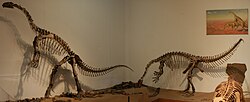Our website is made possible by displaying online advertisements to our visitors.
Please consider supporting us by disabling your ad blocker.
Prosauropoda
| Plateosauridae | |
|---|---|
 Skelet fra en Plateosaurus engelhardti fra Trossingenformationen fra det sydlige Tyskland på Institut for Geovidenskab Tübingen. | |
| Videnskabelig klassifikation | |
| Rige | Animalia (Dyr) |
| Række | Chordata (Chordater) |
| Underrække | Vertebrata (Hvirveldyr) |
| Overklasse | Tetrapoda (Tetrapoder) |
| Klasse | Reptilia (Krybdyr) |
| Overorden | †Dinosauria (Dinosaur) |
| Orden | †Saurischia |
| Underorden | †Sauropodomorpha |
| Familie | Plateosauridae |
| Slægter | |
| Hjælp til læsning af taksobokse | |
Plateosauridae, også kaldet Prosauropoda, var en familie af tidlige dinosaurer af underordenen Sauropodomorpha.[1][2] De levede i Asien, Europa og Sydamerika i sen trias-perioden. Selvom adskillige dinosaurer er blevet klassificerede som tilhørende denne familie over årene, så viste et studie fra 2007 udført af Adam M. Yates kun Plateosaurus og Unaysaurus som medlemmer. Et andet studie fra 2003 udført af Yates slog Sellosaurus sammen med Plateosaurus (som P. gracilis). I 2011 blev Jaklapallisaurus, der er en plateosaur fra Indien, navngivet.[3]
- ^ Yates, Adam M. (2003). "Species taxonomy of the sauropodomorph dinosaurs from the Löwenstein Formation (Norian, Late Triassic) of Germany". Palaeontology. 46 (2): 317-337. doi:10.1111/j.0031-0239.2003.00301.x.
- ^ Yates, Adam M. (2007). "The first complete skull of the Triassic dinosaur Melanorosaurus Haughton (Sauropodomorpha: Anchisauria)". In Barrett & Batten (eds.), Evolution and Palaeobiology: 9-55.
{{cite journal}}: Kursiv eller fed markup er ikke tilladt i:|journal=(hjælp) - ^ Fernando E. Novas; Martin D. Ezcurra; Sankar Chatterjee; T. S. Kutty (2011). "New dinosaur species from the Upper Triassic Upper Maleri and Lower Dharmaram formations of central India". Earth and Environmental Science Transactions of the Royal Society of Edinburgh. 101 (3-4): 333-349. doi:10.1017/S1755691011020093.
Previous Page Next Page


